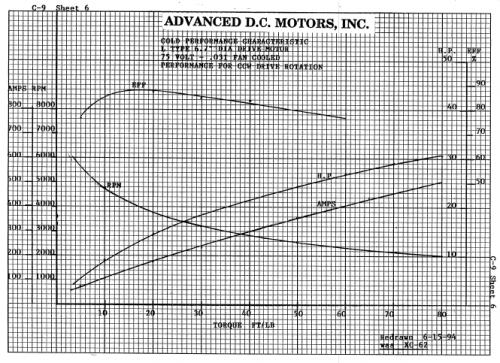Not that I know....yet!
Here is an example, enlighten me, please!

Here is a link to the pdf file: http://www.evmotors.com.au/products/download/L91-4003.pdf
Why does it say: "Redrawn 6-15-94 in bottom right corner? Has this engine been around that long?
Please use this one and any other graph that you can provide to make this a resource for helping people make rational choices about electric motors, transmissions, voltages etc. etc. etc.
Mr. Mik




First think is study some on the math describing a particular motor. Here's a good resource: http://www.gizmology.net/motors.htm
This will help understand some of the relationships that are displayed on the graph. It'll also be a lot easier to understand how the motor is going to perform, and how it will compare to another motor of larger size or different type.
It is important to note that a motor graph has just one input voltage. A DC motor controller varies the voltage to the motor to vary the current flow (and power output) to control speed in an EV, so you'll also need to visualize how the graph will shift with voltage.
Then, you can use the motor graph to help select proper gearing.
[url=/forum-topic/motorcycles-and-large-scooters/587-my-kz750-electric-motorcycle-project]KZ750 Motorcycle Conversion[/url]
[url=/forum-topic/motorcycles-and-large-scooters/588-fixing-my-chinese-scooter]900 watt scooter[/url]
Pic from http://www.electri
Thanks Andrew, I have read and understood the formulas.
But I still don't know how to interpret the graphs.
I think I need to formulate some questions rather than just ask for "how to read it", because there is too much info in there (I hope)!
"If you dont know what to ask, you wont understand the answer, anyway!"
I'll work on my questions...
Thanks!
This information may be used entirely at your own risk.
There is always a way if there is no other way!
Still using this motor performance graph: http://www.evmotors.com.au/products/download/L91-4003.pdf
The only "thingy" shown on the X-axis is torque.
Q 1: What is the right name for "thingy"??
These are wrong names I believe: Value, variable, denominator, or are they??
Anyways,
Q2: can I use the graphs like this:
I look at the AMP curve (the almost straight one):
At 17 FT/LB the motor would be using 160A at 75V, right?
Q3: Can I go straight up from there and deduct that this motor would produce 17FT/LB torque at 4000rpm, using 160A at 75 V, and that that would be the most efficient speed for this engine??
Mr. Mik
This information may be used entirely at your own risk.
There is always a way if there is no other way!
Mik:
Q 1: What is the right name for "thingy"??
The independent variable. It's important to know, because everything else is a function of this. Everything else is known as dependent variables.
For example, lets say you draw a horizontal line on the graph at 200 amps. Than, it might appear like at 200 amps you get 10 hp, 23.5 ft/lbs of torque, and speed of 2,000 rpm. But, this is not how the data was gathered, and those numbers (except the torque) are totally wrong.
Instead, what you need to do, is check the torque at 200 amps, than determine the other parameters based on that torque. So at 23.5 ft/lbs of torque, the motor produces about 15.8 hp, at 3,700 rpm, and 87% efficiency.
Mik:
Q2: can I use the graphs like this:
I look at the AMP curve (the almost straight one):
At 17 FT/LB the motor would be using 160A at 75V, right?
Yes, close. AT 160A the actual input to the motor is 75v - .03I or 70.2v.
Mik:
Q3: Can I go straight up from there and deduct that this motor would produce 17FT/LB torque at 4000rpm, using 160A at 75 V, and that that would be the most efficient speed for this engine??
Yes, but again the actual input voltage to the motor is 70.2v at 160a.
Mik:
"If you dont know what to ask, you wont understand the answer, anyway!"
It's a pretty complex relationship, and it took me a lot of trying to solve problems to understand it better.
[url=/forum-topic/motorcycles-and-large-scooters/587-my-kz750-electric-motorcycle-project]KZ750 Motorcycle Conversion[/url]
[url=/forum-topic/motorcycles-and-large-scooters/588-fixing-my-chinese-scooter]900 watt scooter[/url]
Pic from http://www.electri
the 91, in the L91 (and K91) is the year it was designed... not much new motor desgin has gone into brushed DC motors for a while...
My motor is a K99-4007 and was designed in 99. This was straight from the mouths of Advanced DC tech support.
Here's how to "decode" torque curves:
____________
Travis Gintz
1986 Honda VFR Conversion
www.evfr.net